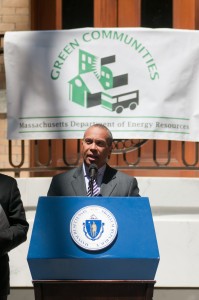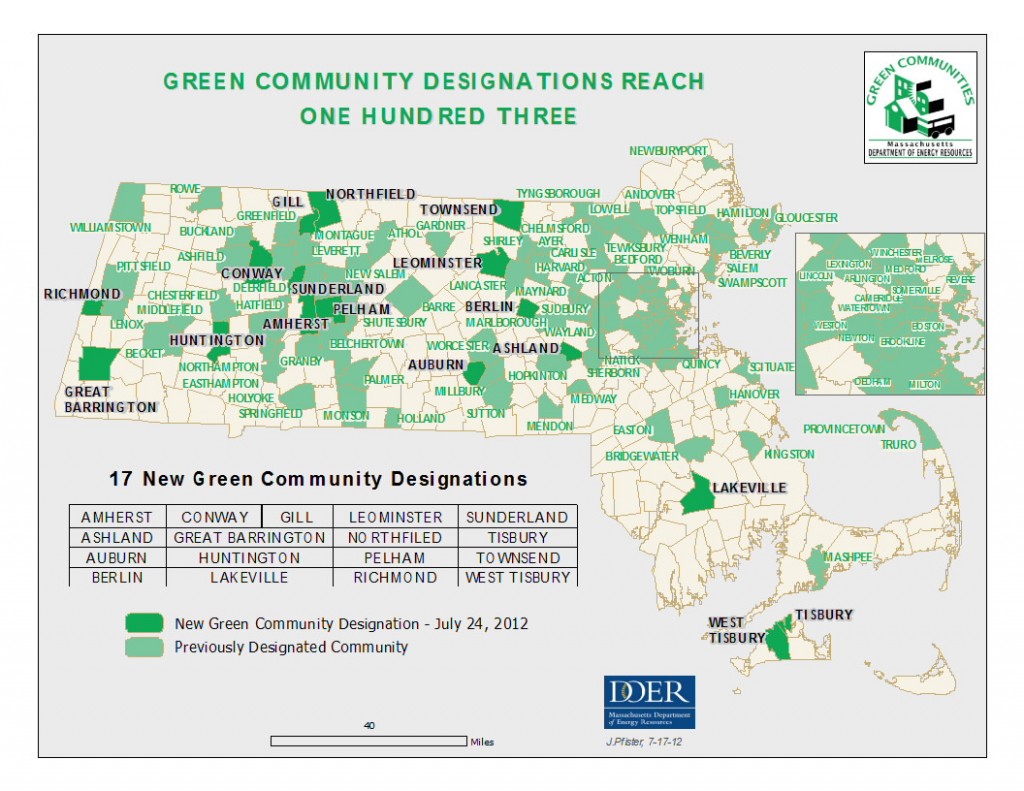BOSTON – Tuesday, July 24, 2012 – Governor Deval Patrick today joined state and local officials to announce that Massachusetts is now home to over 100 Green Communities. At an event at the State House, the Governor announced the designation of 17 new Green Communities, bringing the total number up to 103 cities and towns. Nearly half of Massachusetts residents, or 44 percent, now live in a Green Community.

Governor Patrick offers remarks during an event to make a Green Community milestone. (Photos: Jeremiah Robinson / Governor’s Office)
| With the Department of Energy Resources’ (DOER) designation, Amherst, Ashland, Auburn, Berlin, Conway, Gill, Great Barrington, Huntington, Lakeville, Leominster, Northfield, Pelham, Richmond, Sunderland, Tisbury, Townsend, and West Tisbury will be eligible for nearly $2.75 million in grants for local renewable power and energy efficiency projects. Participating communities have committed to five clean energy leadership criteria – including cutting energy use by 20 percent over five years –spelled out in the nation-leading Green Communities Act, which was passed by the Legislature and signed by Governor Patrick in 2008. |
When Governor Patrick came into office in 2007, he made an ambitious and achievable commitment to clean energy. A major component of that agenda is the Green Communities Act, which empowers communities to invest in local solutions that expand renewable energy adoption, boost the clean energy industry and cut overall energy use. As a result, Massachusetts leads the nation in energy efficiency and has seen the number of renewable energy projects – like solar and wind – soar. There are now more clean energy companies and clean energy jobs in Massachusetts than ever before.
“Surpassing the 100th Green Community mark is a win for every community and our Commonwealth as a whole,” said Governor Patrick. “We have developed a nation-leading clean energy agenda because it is the right thing to do for our environment, our energy independence and our public health. This milestone proves again the clean energy revolution is taking hold, and growing, one community at a time.”
“From Great Barrington in Berkshire County to Tisbury in Dukes County, our communities are committed to promoting clean energy and a green environment,” said Lieutenant Governor Timothy Murray. “Now over 100 Green Communities are making strategic investments to increase energy efficiency and create jobs, improving our economy and quality of life across Massachusetts.”
“I am so proud to hear that Massachusetts is now home to 103 Green Communities,” said House Speaker Robert A. DeLeo. “Adopting clean energy solutions in over a hundred of our cities and towns enhances the economy by creating more green jobs, giving new life to renewable energy companies, and cutting unnecessary energy usage.”
To date, the 103 Green Communities have committed to a total energy reduction equivalent to the annual energy consumption of 13,358 homes. This commitment equates to a greenhouse gas emissions reduction equivalent to taking 22,556 cars off the road.
“Cities and towns across the Commonwealth have stepped up to the challenge of decreasing our dependence on foreign sources of energy,” said Energy and Environmental Affairs Secretary Rick Sullivan. “Keeping our energy dollars in Massachusetts keeps more money in our wallets, boosting our economy, and not one overseas.”
DOER’s Green Communities Designation and Grant Program reward communities that win Green Communities designation by meeting five clean energy benchmarks:
- Adopting local zoning bylaw or ordinance that allows “as-of-right siting” – allowing a project to proceed without requiring a special permit or any time of discretionary approval – for renewable and/or alternative energy research and development facilities, manufacturing facilities or generation units;
- Adopting an expedited permitting process related to the as-of-right facilities;
- Establishing a municipal energy use baseline and a program to reduce use by 20 percent within five years;
- Purchasing only fuel-efficient vehicles for municipal use, whenever such vehicles are commercially available and practicable; and
- Requiring all new residential construction over 3,000 square feet and all new commercial and industrial real estate construction to reduce lifecycle energy costs (i.e. adoption of an energy-saving building “stretch code”).
Once designated by DOER as official Green Communities, cities and towns are eligible for awards to fund local renewable power and energy efficiency projects that advance both municipal and state clean energy goals. Grants awarded so far assist an array of projects across the state, including the installation of solar panels on town office buildings, weatherization at schools and municipal buildings, installation of high-efficiency street lights, and a host of energy efficiency upgrades.
| “With today’s designation, the Commonwealth again demonstrates its commitment to supporting our municipalities while advancing our clean energy goals,” said Senator Benjamin B. Downing, Senate Chairman of the Committee on Telecommunications, Utilities and Energy. “I am proud that communities I represent, Conway, Great Barrington and Richmond, join 100 other Green Communities in committing to these goals through reduced energy use and the encouragement of renewable energy solutions.” |
“I applaud the Administration for its leadership and investment in renewable energy and energy efficiency projects,” said Representative John Keenan, House Chairman of the Committee on Telecommunications, Utilities and Energy. “The Commonwealth continues to lead the nation in promoting renewable energy and energy efficiency, and the Green Communities Program is at the forefront of that effort. Massachusetts’ Green Communities are to be commended for their commitment to clean energy and energy efficiency projects.”

Map of Green Communities by Massachusetts Energy and Environmental Affairs
“Nearly half of the Commonwealth’s residents live in a community that has made a conscious decision to buck the energy status quo and become a leader in renewable energy adoption and smart energy use,” said DOER Commissioner Mark Sylvia. “When we launched Green Communities just a few years ago, we never predicted such an overwhelming response. Becoming a Green Community requires hard work, and this milestone is a testament to the eagerness with which cities and towns large and small have rolled up their sleeves in support of a clean energy future.”
Massachusetts sits at the end of the energy pipeline and imports all of its fossil-fuel based energy sources – some from areas unstable or hostile to the U.S. Of the $22 billion Massachusetts spends annually to buy the energy that runs its power plants, buildings and vehicles, 80 percent flows out of state to places like South America, Canada, and the Middle East. That’s nearly $18 billion in lost economic opportunity that Massachusetts stands poised to reclaim through investments in home-grown renewable energy and energy efficiency projects such as those supported by Green Communities grants.
By the end of this month, Massachusetts will have more than 118 megawatts of solar power. That’s enough electricity to power more than 18,600 homes, and when compared with fossil fuel-generated electricity, the equivalent of taking 9,750 cars per year off the road. Installations this summer alone are poised to be more than five times the total solar power installed in all of 2008. There has been a twenty-fold increase in wind energy to 61 megawatts in just four years, enough to power nearly 19,600 homes. By the end of this year, Massachusetts will be more than halfway to its 2017 goal of 250 megawatts, with five years left to hit the target.
Grants for the communities designated today will be funded by Alternative Compliance Payments (ACP) made by electricity suppliers who do not meet their Renewable Portfolio Standard obligation to purchase a sufficient percentage of renewable energy. Green Communities grants also receive funding from proceeds of carbon allowance auctions under the Regional Greenhouse Gas Initiative (RGGI).
Using a formula that caps awards at $1 million and provides each community with a $125,000 base grant – plus additional amounts based on other criteria, DOER notified the selected communities of their eligibility for the following funding:
| CITY OR TOWN | AMOUNT |
| Amherst | $302,000 |
| Ashland | $164,325 |
| Auburn | $165,550 |
| Berlin | $140,350 |
| Conway | $139,650 |
| Gill | $139,900 |
| Great Barrington | $142,700 |
| Huntington | $140,650 |
| Lakeville | $158,275 |
| Leominster | $245,575 |
| Northfield | $143,750 |
| Pelham | $138,100 |
| Richmond | $137,300 |
| Sunderland | $146,450 |
| Tisbury | $140,925 |
| Townsend | $156,825 |
| West Tisbury | $143,250 |
In addition to grant eligibility, each Green Community designated today will receive a certificate from the Commonwealth and four road signs identifying it as an official Green Community.